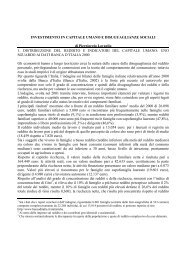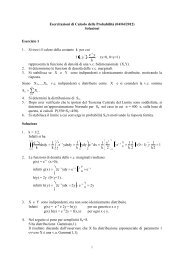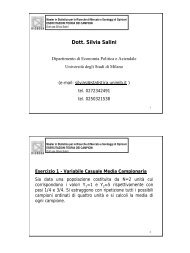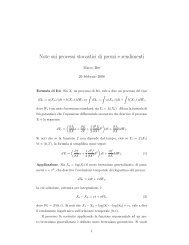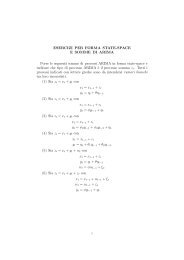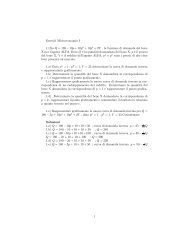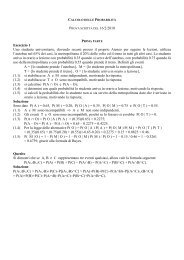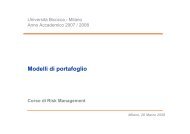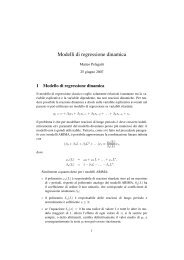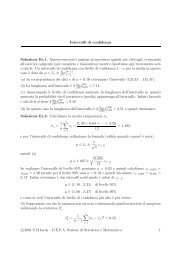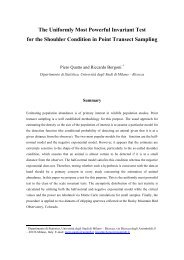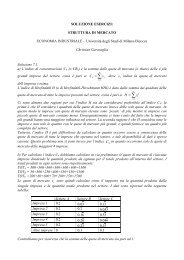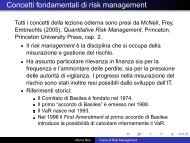Estimating spatial quantities under a design-based framework Abstract
Estimating spatial quantities under a design-based framework Abstract
Estimating spatial quantities under a design-based framework Abstract
You also want an ePaper? Increase the reach of your titles
YUMPU automatically turns print PDFs into web optimized ePapers that Google loves.
ITACOSM 2013Vagheggini, A. 1 , Bruno, F. 2 and Cocchi D. 2<strong>Estimating</strong> <strong>spatial</strong> <strong>quantities</strong> <strong>under</strong> a <strong>design</strong>-<strong>based</strong> <strong>framework</strong><strong>Abstract</strong>Spatial statistics has traditionally used the <strong>spatial</strong> information available before sampling in order todevelop efficient sampling <strong>design</strong>s both <strong>under</strong> the model- and the <strong>design</strong>-<strong>based</strong> <strong>framework</strong>. Sincethe paper by de Gruijter and ter Braak [3] we assisted to a revaluation of <strong>design</strong>-<strong>based</strong> techniquesfor inference on <strong>spatial</strong> data. In more recent papers, Cicchitelli and Montanari [2] and Ghosh et al.[4], different techniques have been proposed able to take into account the <strong>spatial</strong> information in<strong>design</strong>-<strong>based</strong> inference by adopting a model-assisted estimation of global <strong>quantities</strong> and byassigning uncertainty to deterministic interpolated <strong>spatial</strong> surfaces, respectively. However, in ouropinion, literature does not present any fully <strong>design</strong>-<strong>based</strong> technique able to exploit the <strong>spatial</strong>information at estimation level. We proposed an estimator for individual <strong>quantities</strong> coming from a<strong>spatial</strong> finite population, which uses the geographical information available before sampling byreinterpreting a deterministic interpolator <strong>under</strong> the <strong>design</strong>-<strong>based</strong> <strong>framework</strong> [1]. Its statisticalproperties are derived according to the randomness induced by the probabilistic sampling.Moreover, inference for global population <strong>quantities</strong> is also taken into account as a linearcombination of the estimators of individual <strong>quantities</strong> [5].In order to better <strong>under</strong>stand the performances of the technique above, we compare it with thesimple random sampling estimator in predictive form and with the kriging. The former simplyassigns the sampling mean to the unsampled locations, while the latter is a model-<strong>based</strong> techniquewidely regarded as the benchmark for inference on <strong>spatial</strong> data. The performances are computed onthe basis of the results of a Monte Carlo experiment where random samples are drawn at differentsampling fractions from populations generated according to different <strong>spatial</strong> configurations.Therefore, it is possible to <strong>under</strong>stand the behavior of the proposed estimator <strong>under</strong> differentsettings. The results we obtained highlight that the use of the <strong>spatial</strong> information at estimation levelrepresents a major boost when compared to the usual <strong>design</strong>-<strong>based</strong> techniques. Moreover, theachieved estimator has shown performances not as dissimilar from kriging’s ones as one could haveexpected.References[1] Bruno, F., Cocchi, D. and Vagheggini, A. (2012) Finite population properties of individualpredictors <strong>based</strong> on <strong>spatial</strong> patterns, Environ. Ecol. Stat., advance online publication.[2] Cicchitelli, G. and Montanari, G.E. (2012) Model-assisted estimation of a <strong>spatial</strong> populationmean, Int. Stat. Rev. 00, 1_16.[3] de Gruijter, J. and ter Braak, C. (1990) Model-free estimation from <strong>spatial</strong> samples: areappraisal of classical sampling theory, Math. Geol. 22, 407_415.1. Department of Statistical Sciences, University of Bologna, Italy, alessandr.vagheggin2@unibo.it2. Department of Statistical Sciences, University of Bologna, Italy, francesca.bruno@unibo.it;daniela.cocchi@unibo.it
ITACOSM 2013[4] Ghosh, S., Gelfand, A.E. and Mølhave, T. (2012) Attaching uncertainty to deterministic <strong>spatial</strong>interpolations, Stat. Methodology 9, 251_264.[5] Vagheggini, A. (2013) Employing Distances in Design-<strong>based</strong> Spatial Estimation, Ph.D.dissertation, University of Bologna, Italy.1. Department of Statistical Sciences, University of Bologna, Italy, alessandr.vagheggin2@unibo.it2. Department of Statistical Sciences, University of Bologna, Italy, francesca.bruno@unibo.it;daniela.cocchi@unibo.it



